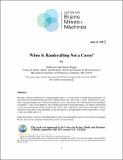| dc.contributor.author | Liao, Qianli | |
| dc.contributor.author | Poggio, Tomaso | |
| dc.date.accessioned | 2018-12-31T15:00:58Z | |
| dc.date.available | 2018-12-31T15:00:58Z | |
| dc.date.issued | 2018-12-31 | |
| dc.identifier.uri | http://hdl.handle.net/1721.1/119833 | |
| dc.description.abstract | Recently, with the proliferation of deep learning, there is a strong trend of abandoning handcrafted sys- tems/features in machine learning and AI by replacing them with “end-to-end” systems “learned from scratch”. These learning paradigms have achieved tremendous success. Researchers show that learning based algorithms are general — they can be applied to new domains and achieve good performance. In contrast, handcrafted systems are becoming the machine learning new “taboo” that is repeatedly criticized in recent papers. Merely motivated by the idea of critical thinking, we ask this question: are handcrafted systems really always a curse? is there any hidden merit of it?
In this short report, we discuss when handcrafted systems can in principle be used to solve tasks in new domains. We also discuss why sometimes handcrafted systems can be preferred. | en_US |
| dc.description.sponsorship | This work was supported by the Center for Brains, Minds and Machines (CBMM), funded by NSF STC award CCF - 1231216. | en_US |
| dc.language.iso | en_US | en_US |
| dc.title | When Is Handcrafting Not a Curse? | en_US |
| dc.type | Technical Report | en_US |
| dc.type | Working Paper | en_US |
| dc.type | Other | en_US |
